Donna Carey, LAc and Ellen F. Franklin, PhD
Oriental Medicine Journal, New Year 2016
On February 8, 2016, we entered into the Year of the Fire Monkey in the Chinese calendar. This article provides an overview of human perceptions of the monkey in science, the media, literature, the natural world, and myths. Monkeys are mischievous, quick, wise, community-focused, and creative charmers, as well as tricksters who may lead you astray. Insights into rich cross-cultural perceptions of the Monkey are also presented.
Monkey Business
 For just a moment consider the English language and the vast number of idioms that invoke the monkey, including monkey business, monkey suit, monkey talk, monkey around, monkey house, hundredth monkey, monkey on your back, monkey’s paw, as much fun as a barrel of monkeys, cheeky monkey, grease monkey, brass monkey, powder monkey, power monkey, monkey bars, I’ll be a monkey’s uncle, monkey see monkey do, throw a monkey wrench in things, come here you little monkey, you clever little monkey, and wise monkey. Many of these expressions are used to highlight silliness, foolishness, aggravation, mischief, restlessness, or trickery. From popular children’s books such as Curious George, originally published in 1941 and still popular today, to movies like the Wizard of Oz (flying monkeys), 2001: a Space Odyssey, Mighty Joe Young, and Raiders of the Lost Ark, monkeys play a major role in popular culture. Even environmental issues incorporate monkey language, such as Edward Abbey’s 1975 novel, The Monkey Wrench Gang, where sabotage was used to protect the environment.
For just a moment consider the English language and the vast number of idioms that invoke the monkey, including monkey business, monkey suit, monkey talk, monkey around, monkey house, hundredth monkey, monkey on your back, monkey’s paw, as much fun as a barrel of monkeys, cheeky monkey, grease monkey, brass monkey, powder monkey, power monkey, monkey bars, I’ll be a monkey’s uncle, monkey see monkey do, throw a monkey wrench in things, come here you little monkey, you clever little monkey, and wise monkey. Many of these expressions are used to highlight silliness, foolishness, aggravation, mischief, restlessness, or trickery. From popular children’s books such as Curious George, originally published in 1941 and still popular today, to movies like the Wizard of Oz (flying monkeys), 2001: a Space Odyssey, Mighty Joe Young, and Raiders of the Lost Ark, monkeys play a major role in popular culture. Even environmental issues incorporate monkey language, such as Edward Abbey’s 1975 novel, The Monkey Wrench Gang, where sabotage was used to protect the environment.
Despite negative, playful, or silly connotations, monkeys also have many positive characteristics, such as quick-wittedness, cleverness, adaptability, creativity, community awareness and concerns, and high intelligence. There are more than 260 species of monkeys divided into two groups, Old World and New World Monkeys. Although monkeys are not a single, coherent group with shared traits, the term “monkey” refers to any simian that is not an ape. New World Monkeys loosely defines those found in Central and South America and in Mexico, and Old World Monkeys are found in Africa, Asia, Japan, and India. The two groupings have distinctive characteristics, with Old World Monkeys having more similarities to humans, including a more developed brain, downward facing nose, sensitive finger tips, and rods and cones in the retina. They also tolerate a much wider range of habitat, including high mountains, rain forests, savannas, semi arid areas, and even cities.
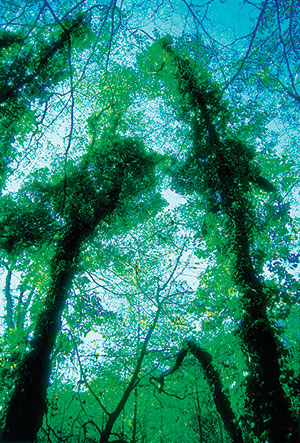 Our relationships with monkeys are complex and controversial, to say the least. They are kept as pets, trained to be service animals for the disabled, and sent into space. Monkeys have been caught in the wild and bred for animal research and laboratory experimentation (to the tune of 200,000 per year). In some cultures, brain of the monkey is considered a delicacy, and their bodies are eaten as bush meat; and if they are perceived as agricultural pests, they are killed. Monkeys have been persecuted and endangered. Their natural habitats are being destroyed; they have been poached, coached, cloned (Tetra II), and put into the space program; and some people even envision future monkey armies.
Our relationships with monkeys are complex and controversial, to say the least. They are kept as pets, trained to be service animals for the disabled, and sent into space. Monkeys have been caught in the wild and bred for animal research and laboratory experimentation (to the tune of 200,000 per year). In some cultures, brain of the monkey is considered a delicacy, and their bodies are eaten as bush meat; and if they are perceived as agricultural pests, they are killed. Monkeys have been persecuted and endangered. Their natural habitats are being destroyed; they have been poached, coached, cloned (Tetra II), and put into the space program; and some people even envision future monkey armies.
Amidst all this annihilation, monkeys have also been elevated as characters in literature, mythology, poetry, painting, comic books, sculpture, and music and featured in movies, television, and documentaries. They are a part of popular culture, art, and science. As messengers, entertainers, ambassadors, tricksters, astronauts, and wisdom keepers, we worship them, study them, and keep them in zoos. Monkeys guard temples, shrines, and stables; and they protect us from disease, evil, and perhaps in the end, our own destruction.
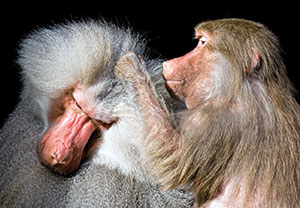 We have habituated to them and understand how much and how deeply we share DNA (we are as genetically related to monkeys as we are to apes). We also share psychological and physical similarities, including the need for social interactions, the ability to bond and form close relationships with our young, and the desire to nurture and care for community. Monkeys groom each other, and they experience and display emotion, including grief, anger, happiness, excitement, and remorse. Their facial expressions are one of the ways that they communicate; and, like humans, they require a lot of mental stimulation and challenges, so that they do not get bored and destructive. They also have their own unique set of fingerprints. It is undeniable that we see our own reflections in the habits, anatomy, and psyche of the monkey.
We have habituated to them and understand how much and how deeply we share DNA (we are as genetically related to monkeys as we are to apes). We also share psychological and physical similarities, including the need for social interactions, the ability to bond and form close relationships with our young, and the desire to nurture and care for community. Monkeys groom each other, and they experience and display emotion, including grief, anger, happiness, excitement, and remorse. Their facial expressions are one of the ways that they communicate; and, like humans, they require a lot of mental stimulation and challenges, so that they do not get bored and destructive. They also have their own unique set of fingerprints. It is undeniable that we see our own reflections in the habits, anatomy, and psyche of the monkey.
Similarities and Differences
There is still heated debate over Darwinian theories, the evolution of the monkey, and our relationship to them, including the age-old debate about the evolution of primates. Scientists continue to explore and unravel the genetic relationship between humans and monkeys.
Even though we seem very different from, if not superior to, the lemurs, monkeys, and apes, we also share behavioral, physical, and psychological traits with other primate family members, especially our closest living relative, the chimpanzee. We share more DNA with this family (having evolved from a common ancestor) than with other mammals, from whom primates split about 65 millions years ago. Ancient Greek, Sumerian, Chinese, Japanese, and East Indian cultures recognized the similarities and connections between humans and other primates. However, it was Carl Linnaeus, a Swedish botanist, physician, and zoologist, who first proposed a taxonomic system in his book, Systema Naturae, published in 1735, that actually places monkeys, apes, and humans in the class of primates.
One key to understanding human evolution is provided by looking at when apes and humans made their break from Old World Monkeys. In other words, when did the hominoid lineage first appear? Genetic analysis of humans, other primates, and monkeys places the separation at 30 million years ago. However, the origin of anthropoids, the simian, or higher primates, which include Old World Monkeys and apes, humans, and New World Monkeys, is still full of controversy. One theory identifies the split as occurring in Africa, about 30 million years ago. However, new fossils found in Asia suggest that a hybrid may have existed around 28-29 million years ago that was a cross between an Old World Monkey and an ape, and that while anthropoids became extinct in Asia, they migrated to Africa, a place where they could develop and evolve (out of Asia theory). This fossil is a very important discovery because it reveals a previously unknown species that may have emerged before our lineage split from Old World Monkeys.
 There was tremendous climate change on Earth 30 million years ago, and it is likely that the monkey evolved in response to these dramatic environmental changes. Perhaps they were large, similar to apes, but got smaller over time to enable them to live in trees, accessing food above the ground, and creating shelters from predators. Other unique traits, such as opposable thumbs, allowed them to adapt and change with their environment to ultimately survive and evolve. Monkeys are extremely intelligent, with demonstrated ability to problem solve effectively. If an environment did not meet their survival demands, they moved on to find new sources of shelter, food, and water. Some learned to swim, which allowed them to escape predators (or find new ones such as the alligator) and to find new sources of food. Monkeys are emotional; they form strong bonds, nurture their young, and care for one another, which is clearly part of the evolutionary process they share with all primates.
There was tremendous climate change on Earth 30 million years ago, and it is likely that the monkey evolved in response to these dramatic environmental changes. Perhaps they were large, similar to apes, but got smaller over time to enable them to live in trees, accessing food above the ground, and creating shelters from predators. Other unique traits, such as opposable thumbs, allowed them to adapt and change with their environment to ultimately survive and evolve. Monkeys are extremely intelligent, with demonstrated ability to problem solve effectively. If an environment did not meet their survival demands, they moved on to find new sources of shelter, food, and water. Some learned to swim, which allowed them to escape predators (or find new ones such as the alligator) and to find new sources of food. Monkeys are emotional; they form strong bonds, nurture their young, and care for one another, which is clearly part of the evolutionary process they share with all primates.
That Traits Distinguish Primates?
Anthropologists have identified physical and behavioral traits that link humans to other primates. Foremost is superlative vision - forward facing eyes that sit fairly close together, allowing optic field overlap to create 3D vision. Part of that great vision may be the presence of a ring of bone surrounding the eyeball or in some cases complete enclosure of the eye by a bony socket as protection from contractions of the chewing muscles. Compared with other mammals, the primate sense of smell is less acute, as primates depend on their vision much more.
Primates are extremely dexterous, possessing great skills to manipulate objects. They have opposable thumbs and big toes, as well as tactile finger pads. Most primates have nails instead of claws, and five fingers on each hand or foot. Unlike many other mammals, primates have collarbones to allow for greater shoulder mobility. They have larger brains and smaller litters, birthing one baby at a time, as well as longer gestation and childhood periods.
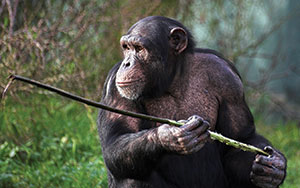 Monkeys have the intellectual ability to do math similar to college students. They possess humanlike skills in feeding, such as cracking nuts open with stones, using sticks to dig out termites and ants from trees, and cupping their hands or folding large leaves to hold water in order to drink. Some monkeys are monogamous, and some gamble. They recognize their families even if they were separated at birth. Monkeys are able to make tools and weapons. If they are stressed or bullied, it affects their immune systems. They judge social interactions and inequality, shunning selfish actions by other monkeys and humans. Monkeys also like to party; they will get drunk on palm wine and over-ripe fruits, and they will beg for food. They love rituals, especially grooming and reproduction. They have a content-based language that may have its roots in monkey song (namely alarm calls), and male monkeys will give up juice rewards to ogle pictures of female bottoms. Lip smacking is a friendly gesture; increased lip smacking equals increased group harmony and cohesion. Lip smacking vocalizations produce speechlike sounds that may prove an important step in the evolution of human speech. Monkeys also shout during sex to help their partners climax, and they use sex toys and masturbate. They also drum to activate their brain networks, which may be linked to communication and message sending, particularly in regard to power and status. Monkey communication may shed light on the origins of language and music. Like humans, monkeys sneeze, yawn, grimace, eat junk food to calm their nerves, and seek out quiet spots to avoid noise pollution. They are also quite adept at using many human devices, such as touch screens, which help them to relax; they play fairly, laugh out loud, play with gender specific toys, and recognize faces.
Monkeys have the intellectual ability to do math similar to college students. They possess humanlike skills in feeding, such as cracking nuts open with stones, using sticks to dig out termites and ants from trees, and cupping their hands or folding large leaves to hold water in order to drink. Some monkeys are monogamous, and some gamble. They recognize their families even if they were separated at birth. Monkeys are able to make tools and weapons. If they are stressed or bullied, it affects their immune systems. They judge social interactions and inequality, shunning selfish actions by other monkeys and humans. Monkeys also like to party; they will get drunk on palm wine and over-ripe fruits, and they will beg for food. They love rituals, especially grooming and reproduction. They have a content-based language that may have its roots in monkey song (namely alarm calls), and male monkeys will give up juice rewards to ogle pictures of female bottoms. Lip smacking is a friendly gesture; increased lip smacking equals increased group harmony and cohesion. Lip smacking vocalizations produce speechlike sounds that may prove an important step in the evolution of human speech. Monkeys also shout during sex to help their partners climax, and they use sex toys and masturbate. They also drum to activate their brain networks, which may be linked to communication and message sending, particularly in regard to power and status. Monkey communication may shed light on the origins of language and music. Like humans, monkeys sneeze, yawn, grimace, eat junk food to calm their nerves, and seek out quiet spots to avoid noise pollution. They are also quite adept at using many human devices, such as touch screens, which help them to relax; they play fairly, laugh out loud, play with gender specific toys, and recognize faces.
There is such a wealth of material on monkeys and their relationships with humans that we have only shared a small amount in this article. There are numerous scholarly articles on the web with a great deal more information on this topic. A few of these sources are provided in the reference list below, as well as an overview of known monkey facts.
Monkey Facts:
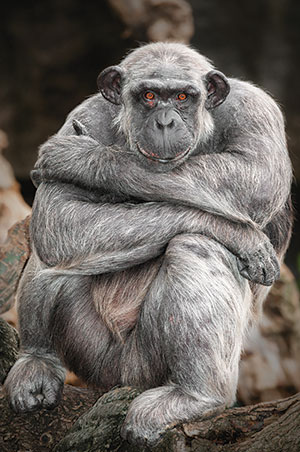 At least 264 known monkey species
At least 264 known monkey species- Classified as Cercopithecoid (Old World Monkey) or Platy rrhyne (New World Monkey)
- As small as 6” and weighing just 4 ounces, and as large a s 3’ and 77 pounds
- Eyes face forward
- Some see in Technicolor, others in black and white
- Opposable thumbs that assist with climbing and food gathering
- Long powerful tails
- Susceptible to many diseases, but not the common cold
- Live in groups of a few or as many as twelve members
- Facial expressions are a way of communicating
- Affection for one another is expressed similar to humans
- Mourn loss, display happiness, sadness, anger, and many other human emotions
- Keen curiosity that leads to trouble
- Groom as part of socializing and bonding
- Many monkeys live in arboreal forests in trees; others go back and forth between trees and land
- Considered pests in some regions
- Albert II was the first monkey in the space program
- Zodiac sign in the Chinese calendar
- Popular exotic pets
Monkey Diets:
Monkeys find creative ways to meet their nutritional needs in the wild and to support the rejuvenation of their food supply, including spreading seeds from plants, flowers, and fruits. Monkeys eat and drink:
- Fruits
- Ripe fruit/wine
- Leaves
- Bark and twigs
- Tree sap
- Flowers
- Bugs and insects
- Nuts
- Ants and termites
- Water
Monkey Habitats:
Monkeys move a great deal to search for food, so they do not stay in a nest very long. Human activities, such as the building of roads through forests, logging, clear cutting, agriculture, and development of cities, have cut monkey habitat by an alarming 35%. Monkeys are also hunted, stolen, and poached in their natural habitats, and are in dire need of protection and conservation efforts. Many monkey species are at risk. They live in:
- Forest regions
- Savannahs
- Trees
- Evergreen forests
- Mangrove forests
- Mountains
Monkey Predators:
- Birds
- Large cats
- Hyenas
- Other primates like chimpanzees and humans
- Humans trap, kill, poach, and sell young monkeys as pets
- Alligators
Monkey Reproduction:
- Full of ritual
- No set breeding period—as long as basic needs are met, they will reproduce
- When stressed, or food and shelter are in short supply, females stop going into estrus. They will not mate again until they can support themselves and their young (imagine that)
- Gestation period is 160 days
- Twins are rare
- They give birth only every couple of years
- Mating begins at ages 4-8
- Young monkeys spend a lot of time on their mothers’ backs and in their arms
- Monkeys are excellent, nurturing parents who encourage their young to vocalize, find food, and play, and who scold them for bad behavior
Things That Distinguish Humans:
- Speech
- Upright posture
- Nakedness (lack of hairiness)
- Flexibility of hands and fingers, grip
- Extraordinary brains
- Clothing
- Fire
- Blushing
- Long childhoods
- Life after children (most animals reproduce until they die)
Things That Make Other Primates Like Humans:
- They shake their heads to signify “no”
- Beg for food
- Laugh out load
- Recognize faces
- Eat junk food to calm their nerves
- Use sex toys
- Use gender specific toys
- Play fairly (or monkey around)
Popular Movies with Monkeys:
- 2001: A Space Odyssey
- Planet of the Apes
- Wizard of OZ (flying monkeys)
- Pirates of the Caribbean
- The Jungle Book
- Every Which Way But Loose
- Mighty Joe Young
- Raiders of the Lost Ark
Folktales and Myths about Monkeys
 Monkey myths and folktales are found throughout the world from Africa to the Americas. Monkeys will often appear in human-like form, smart, curious, creative, and often full of mischief. In many cultures they were companions and helpers to the gods. The Mayas identified twin monkey brothers who ruled over the arts including music, dance, sculpture, and writing. In some of these myths Spider Monkey is associated with trickery and fun and Howler Monkey with work and responsibility. Hanuman of India, who dates to around 500 BC, was a healer, pharmacologist, poet, and son of the wind. He is also credited with the development of homeopathic medicines and having the ability to restore the wounded to health. He was worshipped for his bravery, devotion, loyalty, and sense of justice. In Japan a wood carving on a seventeenthcentury Buddhist shrine depicts three wise monkeys believed to represent mindfulness, thoughtful speech, and right action. While various meanings are ascribed to them, one theory put forth is that they were used to represent Confucius’ code of conduct. The myth retold below is that of Sun Wu Kung, the famous Monkey King of China.
Monkey myths and folktales are found throughout the world from Africa to the Americas. Monkeys will often appear in human-like form, smart, curious, creative, and often full of mischief. In many cultures they were companions and helpers to the gods. The Mayas identified twin monkey brothers who ruled over the arts including music, dance, sculpture, and writing. In some of these myths Spider Monkey is associated with trickery and fun and Howler Monkey with work and responsibility. Hanuman of India, who dates to around 500 BC, was a healer, pharmacologist, poet, and son of the wind. He is also credited with the development of homeopathic medicines and having the ability to restore the wounded to health. He was worshipped for his bravery, devotion, loyalty, and sense of justice. In Japan a wood carving on a seventeenthcentury Buddhist shrine depicts three wise monkeys believed to represent mindfulness, thoughtful speech, and right action. While various meanings are ascribed to them, one theory put forth is that they were used to represent Confucius’ code of conduct. The myth retold below is that of Sun Wu Kung, the famous Monkey King of China.
Myth of the Monkey King
One of the most famous stories in China is that of the Monkey King, Sun Wu-Kung, retold in the classic, Journey to the West, written by Wu Cheng’en. This early novel was originally published in the 16th century during the Ming Dynasty. The enduring story traces its origins to Chinese mythology as well as to Buddhist and Taoist philosophy. Some scholars say that it is based on a true story of Xuan Zang, a monk who lived during the Tang Dynasty and who traveled on foot to India, where he was given the Sutras, which he brought back to China and translated, thus bringing Buddhism to China. The Monkey clearly predates Buddhism in China, as it appears as part of the Chinese Zodiacal system perhaps as early as 4000 BC. Hanuman, the Monkey God of India, dates to approximately 500 BC.
In the beginning, on a far away island, a rock soaked up the energy of heaven and earth and became pregnant amidst the primal chaos of the Universe. From this rock emerged a stone egg, which cracked open to release into the world Monkey. Aware of his sacred creation from the elements, upon his birth, Monkey honored the four directions and the five elements of his creation, bowing to the corners of the Earth and giving thanks to the Heavens. However, this solemnity lasted but a moment in time as the high-spirited Monkey leaped off into the newly formed world in search of adventures. Full of himself from his divine birth, he named himself Handsome Monkey King and ruled over a kingdom of monkeys on the remote island of his birth, where for many years he was content to engage in all sorts of high-spirited and mischievous activities.
As the years passed, the ever-curious Monkey, longing for greater adventures, began to worry about his own mortality. As his fear of death grew, his pranks became more and more troublesome. Tired of Monkey’s actions, wise old monkey, just before his death, suggested that Monkey seek out the Taoist Sage Father Subodhi, who held the keys to immortality.
Without giving it a second thought, Monkey left his beloved island and set off on a long journey to the far mountains in search of the great Taoist sage. Upon his arrival, he demanded to be trained, but wise sage was unimpressed and ignored him, although after a brief acquaintance he named him Disciple Aware of Emptiness. This epitaph referred to the hollowness the great sage witnessed in his student. Not known for his patience, Monkey persisted in wrangling, cajoling, and disrupting Father Subodhi’s peaceful practice and contemplation. Eventually Monkey proved to be a worthy student who was taught martial arts, seventy-two transformations, cloud dancing, and how to jump thousands of miles. But ever true to his monkey nature, the Monkey king was expelled when sage grew tired of his arrogance and pranks.
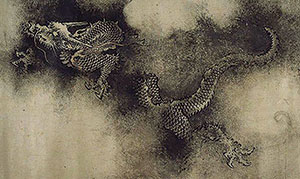 Returning to his island home he discovered that, in his absence, it was taken over by fearsome monsters. Monkey quickly learned that even all his newfound skills were not enough to defeat the monsters; he needed a new weapon. Cleverly he sought out the Dragon King and wheedled his way into the vast treasury in search of weapons. A huge rod of blackest iron immediately caught his eye and to his great surprise he realized that it was the very tool used to flatten the Milky Way. At rest, the weapon was 13,000 pounds of menace that could expand to fill the Universe—or shrink to the size of a needle. Delighted with this perfect discovery, Monkey shrank it down to a needle (better to surprise those demons) and tucked it behind his ear. Returning home well armored, he quickly slew the demons. Quite impressed with his powers, his ego grew, and grew; casting his eyes to the heavens, he believed himself as powerful as the gods.
Returning to his island home he discovered that, in his absence, it was taken over by fearsome monsters. Monkey quickly learned that even all his newfound skills were not enough to defeat the monsters; he needed a new weapon. Cleverly he sought out the Dragon King and wheedled his way into the vast treasury in search of weapons. A huge rod of blackest iron immediately caught his eye and to his great surprise he realized that it was the very tool used to flatten the Milky Way. At rest, the weapon was 13,000 pounds of menace that could expand to fill the Universe—or shrink to the size of a needle. Delighted with this perfect discovery, Monkey shrank it down to a needle (better to surprise those demons) and tucked it behind his ear. Returning home well armored, he quickly slew the demons. Quite impressed with his powers, his ego grew, and grew; casting his eyes to the heavens, he believed himself as powerful as the gods.
Monkey’s antics did not go unnoticed. The Dragon King called upon Jade Emperor to complain bitterly about the theft of his precious weapon. No sooner had the Dragon King departed than the King of Death arrived in a rage, angered by the theft of his minions—for Monkey had granted immortality to all monkeys. The Emperor knew a speedy response was imperative. He called Monkey before him, offering the position of Keeper of the Heavenly Stables. Initially impressed with his lofty position, Monkey’s satisfaction was short lived for he quickly realized horse manure was valued more highly than he was.
Not one to hold back, the enraged Monkey confronted the Jade Emperor, threatening unspeakable acts. In an effort to appease Monkey, the Emperor, with the support of his advisors, bestowed the name The Great Sage Equal to Heaven upon Monkey King. Now one might think that this would result in Monkey embracing the qualities of a wise and thoughtful sage; but, alas, true to his
nature, he did not embody his name. He immediately went on a tear, eating Lao Tzu’s longevity pills and gobbling up the Peaches of Immortality, not to mention heaping insults on all the gods. As if that were not enough, Monkey then declared Heaven as just too boring and headed home to his island.
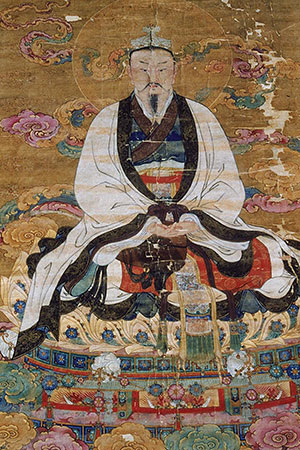 Enraged by his antics, the gods sent the Army of Heaven in hot pursuit. But, alas, the Emperor’s army was no match for the great Monkey, who now embodied heavenly essence, immortality, shape shifting, and exemplary fighting skills, not to mention his well trained and extremely tricky immortal monkey army. The forces of Heaven retreated many times to come back with reinforcements. Eventually bored with the game of war, in a moment of distraction Monkey was quickly subdued and tossed into Lao Tzu’s caldron to be cooked unto his death. But immortality and his formidable strength prevented his extermination. In the heat of the caldron, his eyes grew diamond hard and his pupils became flaming red, but no monkey stew would be served in the heavens. Clever Monkey escaped the cauldron, causing havoc once again in Heaven. His only apparent weakness from his ordeal was a sensitivity to smoke.
Enraged by his antics, the gods sent the Army of Heaven in hot pursuit. But, alas, the Emperor’s army was no match for the great Monkey, who now embodied heavenly essence, immortality, shape shifting, and exemplary fighting skills, not to mention his well trained and extremely tricky immortal monkey army. The forces of Heaven retreated many times to come back with reinforcements. Eventually bored with the game of war, in a moment of distraction Monkey was quickly subdued and tossed into Lao Tzu’s caldron to be cooked unto his death. But immortality and his formidable strength prevented his extermination. In the heat of the caldron, his eyes grew diamond hard and his pupils became flaming red, but no monkey stew would be served in the heavens. Clever Monkey escaped the cauldron, causing havoc once again in Heaven. His only apparent weakness from his ordeal was a sensitivity to smoke.
Now at his wit’s end, the Emperor sought the aid of Buddha to help subdue the Monkey King. Of course, Buddha had seen it all. Wise to the ways of Monkey, he offered a bet. “If you can jump off the palm of my hand, I will demote the Emperor and hand Heaven over to you. Of course, if you fail at this endeavor, your most humble apology will be expected.” The Monkey had no problem going for this bet, for he surely knew that he could jump thousands of miles in just one leap, and so he willingly stepped into the palm of Buddha. Arrogant as ever, Monkey soared through the air to land in a large open plain with five pillars before him. Proud of his accomplishment, he marked his territory with pee and raced back, exultant to claim his reward. Buddha looked down in surprise, wondering why Monkey was so happy. But, in a flash, Monkey noticed the noxious smell of monkey pee and knew that he had never left the hand of Buddha. Before Monkey could react to this failure Buddha tossed him to the ground and covered his body with a giant mountain, where he stayed for five hundred long years.
 The Monkey had lots of time to think; and, while not humbled by his experiences, he was at least receptive to the request of Kwan Yin, the Goddess of Mercy, when she sought him out to protect the young Buddhist monk Tripitaka on his journey to India to obtain the sutras. Of course Kwan Yin took no chances. Before Monkey was released and sent on this journey, she crafted a golden headband and placed it upon his head. If Monkey’s nature got the best of him, Tripitaka would recite the sutras and the band would tighten around his head, resulting in a massive, crushing headache. The the journey to the West, filled with new friends and many adventures, eventually proved victorious. The scriptures were obtained from Buddha and brought back to China. For his efforts the Monkey King was named Buddha of Victory through Strife. The great sage, humbled by his journey and proud of his new name, adapted to a life of clever service.
The Monkey had lots of time to think; and, while not humbled by his experiences, he was at least receptive to the request of Kwan Yin, the Goddess of Mercy, when she sought him out to protect the young Buddhist monk Tripitaka on his journey to India to obtain the sutras. Of course Kwan Yin took no chances. Before Monkey was released and sent on this journey, she crafted a golden headband and placed it upon his head. If Monkey’s nature got the best of him, Tripitaka would recite the sutras and the band would tighten around his head, resulting in a massive, crushing headache. The the journey to the West, filled with new friends and many adventures, eventually proved victorious. The scriptures were obtained from Buddha and brought back to China. For his efforts the Monkey King was named Buddha of Victory through Strife. The great sage, humbled by his journey and proud of his new name, adapted to a life of clever service.
References
Abbey, E. (1975). The monkey wrench gang. New York, NY: Harper Collins.
Byrne, R. & White, A. (1989). Machiavellian intelligence: Social expertise and the evolution of intellect in monkeys, and apes and humans. Oxford, UK: Oxford Science Publications.
Cantlon, Jessica F. (2012). Math, monkeys, and the developing brain. Proceedings of the National Academy of Science, 29, 10725-10732.
Cantlon, Jessica F., & Brannon, Elizabeth M. (2007). Basic math in monkeys and college students. PLoS Biol 5(12): e328. doi:10.1371/journal.pbio. DOI: 10.1371/journal.pbio.0050328
Gorman, J. (2015, May 18). Monkeys provide clues to how tool use developed. New York Times. Retrieved from http://www.nytimes.com/2015/05/18/science/monkeys-provide-clues-to-how-tooluse- developed.html
Krisch, J.A. (2014, December 19). Monkey see monkey speak: Scientists use language and logic to translate monkey sounds into English and develop linguistic rules for primate dialects, Scientific American. Retrieved from http://www.scientificamerican.com/ article/monkey-see-monkeyspeak-video/
Journey to the West, New World Encyclopedia. Retrieved from http://www.newworldencyclopedia.
org/entry/Journey_to_the_West
Monkey World Ape Rescue Center. Retrieved from http://www.monkeyworld.org/home.php
Rey, M.E., & Rey, H.A. (1941). Curious George. New York, NY. Houghton Mifflin.
Siefring, J. (Ed.) (2004). The Oxford dictionary of idioms, 2nd Ed, Oxford, UK, Oxford University Press.
Wayman, E. (2012, Oct, 29). Why are Humans Primates? Smithsonian Magazine. Retrieved from Smithsonianmag.com/science-nature
Wilson, E. O. (2014). The meaning of human existence. New York, NY: Liveright Publishing Corporation.
Zabludoff, M. (2008). Monkeys. Tarrytown, NY: Marshall Cavendish Benchmark.

